Publishing Since 1983
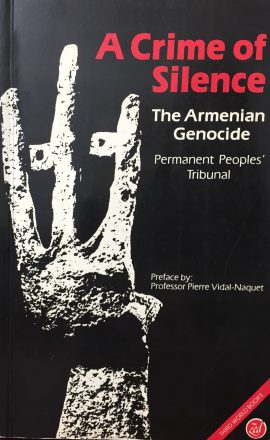
A Crime of Silence
Author: Permanent Peoples’ Tribunal
Year: 1985

A Crime of Silence
Author: Permanent Peoples’ Tribunal
Year: 1985
The 1984 Paris Permanent Peoples’ Tribunal provided the first international, legal forum to publicly detail and document the guilt of the Young Turk government in perpetuating the genocide of the Armenian people between 1915 to 1917. The evidence-based landmark ruling transpired into the seminal book which serves to bring this imprescriptible crime to the world’s attention.
A Crime of Silence, which brings together the contributions of specialists, among whom Yves Ternon, Richard Hovannisian, Pierre Vidal-Naquet, and Zoryan Institute’s Director of Research Vahakn N. Dadrian, presents the facts and their interpretation, including the Turkish theories. At a time when universal human rights are being rigorously tested, A Crime of Silence is an essential work to comprehend the first genocide of the 20th Century.
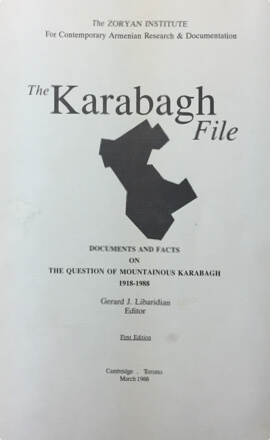
The Karabagh File
Author: Edited by Jiraryr Libaridian
Year: 1988

The Karabagh File
Author: Edited by Jiraryr Libaridian
Year: 1988
In late February 1988, the world was shocked by a week-long series of demonstrations in Yerevan, capital of the Armenian S.S.R., one of the fifteen republics of the Soviet Union. Although peaceful, the place, size, length, and apparent suddenness of the demonstrations brought to world consciousness names of people and places as intractable as the issues they embody. The sights and sounds of hundreds of thousands of demonstrators seeking to influence policy makers in the central government of the U.S.S.R. and bring about changes in internal boundaries highlighted the promise and challenge of glasnost and perestroika.
The question of Mountainous Karabagh also raised the thorny issue of Soviet nationalities policy. Through the extensive use of original documents, maps, statistical data, a chronology, and photographs covering the last eighty years, the Zoryan Institute and its staff provide the reader not only the necessary information but also the context within which it is possible to analyze the problems.
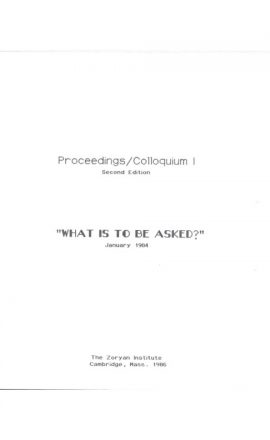
What Is To Be Asked
Author: The Zoryan Institute
Year: 1984

What Is To Be Asked
Author: The Zoryan Institute
Year: 1984
The purpose of the colloquia initiated by the Zoryan Institute for Contemporary Armenian Research and Documentation, Inc. is to provide a forum to scholars, intellectuals, and community members to discuss fundamental issues, to raise substantial questions, and to help develop new perspectives relevant to the modern history and culture of the Armenian people.
The Board of Directors of the Institute hopes that these colloquia will encourage speculative thinking and scholarly research in areas critical to contemporary Armenian studies.
The first colloquium convened on two consecutive days in January 1984 at Tufts University, Medford, Mass. and at the Zoryan Institute headquarters. The format was simple. The first session consisted of three presentations and three comments. The remaining time was devoted to open discussion.
By releasing the transcript of the proceedings, we hope to enlarge the circle of participants in the discussions and to make the process a continuing one.
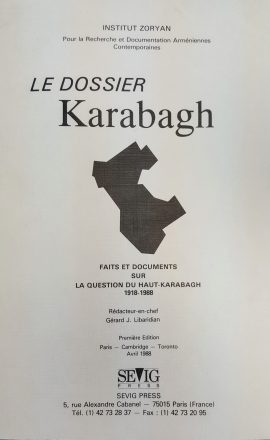
Le Dossier Karabagh
Author: Edited by Jiraryr Libaridian
Year: 1988

Le Dossier Karabagh
Author: Edited by Jiraryr Libaridian
Year: 1988
In late February 1988, the world was shocked by a week-long series of demonstrations in Yerevan, capital of the Armenian S.S.R., one of the fifteen republics of the Soviet Union. Although peaceful, the place, size, length, and apparent suddenness of the demonstrations brought to world consciousness names of people and places as intractable as the issues they embody. The sights and sounds of hundreds of thousands of demonstrators seeking to influence policy makers in the central government of the U.S.S.R. and bring about changes in internal boundaries highlighted the promise and challenge of glasnost and perestroika.
The question of Mountainous Karabagh also raised the thorny issue of Soviet nationalities policy. Through the extensive use of original documents, maps, statistical data, a chronology, and photographs covering the last eighty years, the Zoryan Institute and its staff provide the reader not only the necessary information but also the context within which it is possible to analyze the problems.
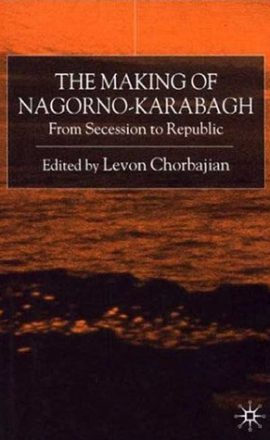
The Making of Nagorno-Karabagh From Secession to Republic
Author: Edited by Levon Chorbajian
Year: 2001

The Making of Nagorno-Karabagh From Secession to Republic
Author: Edited by Levon Chorbajian
Year: 2001
The first major territorial struggle in the late Soviet period involved Nagorno-Karabagh, an Armenian inhabited territory that had been assigned to the Azerbaijan Soviet Socialist Republic in the early 1920s. Armenian protests calling for reunification with Armenia in 1988 led to Azerbaijani pogroms against Armenians and later to armed conflict that claimed over twenty thousand lives. The struggle remains unresolved. A distinguished group of historians and social scientists analyze the Karabagh struggle in this unique volume that covers one of the world’s strategic, oil-rich regions.
A striking feature of the Karabagh conflict is the failure of the many OSCE, UN, and regional power mediation efforts to find a solution to the crisis. One of the major contributions of this volume is to provide a cogent analysis of these failures, which have to do with the inability to satisfy the legitimate security needs of the parties to the conflict, and, especially, Armenia, Azerbaijan, and Nagorno-Karabagh.
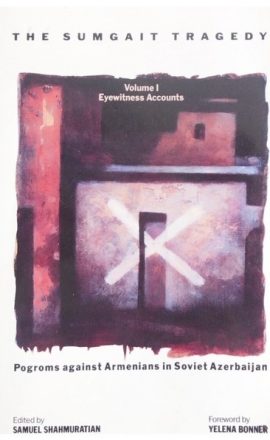
The Sumgait Tragedy
Author: Edited by Samuel Shahmuratian
Year: 1990

The Sumgait Tragedy
Author: Edited by Samuel Shahmuratian
Year: 1990
The pogroms against Armenians in February 1988 in Sumgait blocked a political solution to the peaceful demands of the Armenians for self-determination. They brought death to a community and ran people out of their homes. They showed the helplessness or unwillingness of a powerful government to protect its people.
In The Sumgait Tragedy, forty-five eyewitnesses and victims of the attacks tell what they saw and suffered. The accounts, based on tape-recorded interviews, also make clear what the Armenians did not see: a serious, effective effort by authorities to fulfill the first duty of any government – to protect its citizens. Why were warnings that violence was ready to flare up not heeded? Why did measures taken to halt the attacks come too late? How accurate is the Soviet description of the events as the violence of a small group of hooligans?
Such questions go beyond the fate of the victims of the Sumgait pogroms. They raise doubts about the motives of the current Soviet government and about its ability to meet the rightful demands of its peoples. As Yelena Bonner writes, “…our regime fears unsanctioned popular movements more than anything else… the government’s lack of understanding and its inability to cope provided time for the dark forces to plan what happened in Sumgait.”
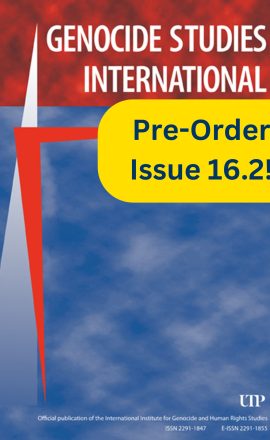
Pre-Order GSI Special Issue 16.2
Author:
Year:
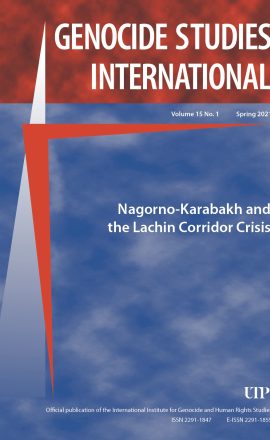
GSI Special Issue: Nagorno-Karabakh and the Lachin Corridor Crisis
Author: Henry Theriault, Alex Alvarez, Jennifer Rich, and Adam Muller
Year: 2023

GSI Special Issue: Nagorno-Karabakh and the Lachin Corridor Crisis
Author: Henry Theriault, Alex Alvarez, Jennifer Rich, and Adam Muller
Year: 2023
The blockade of the vital road connecting Armenia with the enclave of Artsakh (Nagorno-Karabakh) – the Lachin Corridor, is an ongoing human rights emergency that threatens the safety and security of the entire region.
Given the urgency of this situation and the risks this manufactured crisis has for escalation into more extreme policies of violent persecution, ethnic cleansing and genocide, the editors of Genocide Studies International, published by the University of Toronto Press and sponsored by the Zoryan Institute, have commissioned a special issue of the journal to directly address what is currently happening on the ground.
Comprised of 6 scholarly contributions from notable international experts on the region, this issue is intended to raise awareness of this ongoing crisis and to provide critical insight into the risks this blockade poses the ethnic Armenian inhabitants of Artsakh and for the peace and security of the entire region.
The print copies of this issue will be available in print by August 25, 2023. Pre-order your copies today at a special price of only $25 CAD! For large orders please contact zoryan@zoryaninstitute.org.
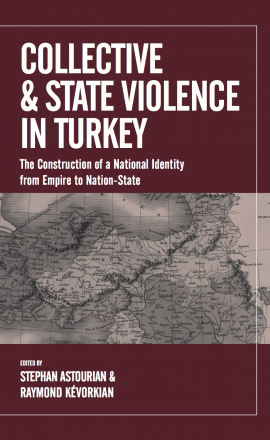
Collective and State Violence in Turkey: The Construction of a National Identity from Empire to Nation State
Author: Stephan Astourian
Raymond Kévorkian
Year: 2020

Collective and State Violence in Turkey: The Construction of a National Identity from Empire to Nation State
Author: Stephan Astourian
Raymond Kévorkian
Year: 2020
Turkey has gone through significant transformations over the last century – from the Ottoman Empire and Young Turk era to the Republic of today – but throughout it has demonstrated troubling continuities in its encouragement and deployment of mass violence. In particular, the construction of a Muslim-Turkish identity has been achieved in part by designating ‘internal enemies’ at whom public hatred can be directed.
This volume provides a wide range of case studies and historiographical reflections on the alarming recurrence of such violence in Turkish history. It shows not only how atrocities against ethnic-religious groups have propelled the nation’s very sense of itself, but also how the impunity of these atrocities has contributed to broader patterns of violence in the Middle East, including the rise of ISIS and other non-state actors and their violence against minorities, such as Yazidis.
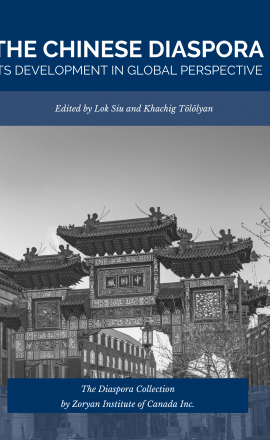
The Chinese Diaspora: Its Development in Global Perspective
Author: Lok Siu & Khachig Tölölyan
Year: 2020

The Chinese Diaspora: Its Development in Global Perspective
Author: Lok Siu & Khachig Tölölyan
Year: 2020
The Chinese Diaspora: Its Development in Global Perspective is an accessible and valuable text for anyone studying or interested in this increasingly important subject.
The collection features three overarching areas that both shape and are shaped by the diaspora – culture, entrepreneurship, and migration – and highlights the heterogeneity of Chinese diasporic communities in historical context, as well as their relationships with the homeland and adopted nation-states. It presents carefully selected case studies that span across North America, Latin America, Africa, and Asia.
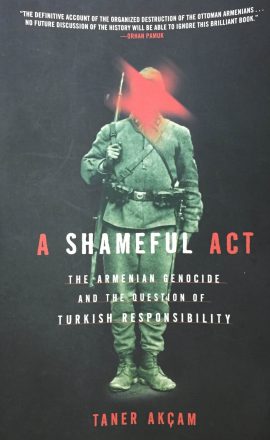
A Shameful Act
Author: Taner Akçam
Year: 2006

A Shameful Act
Author: Taner Akçam
Year: 2006
Beginning in 1915, under the cover of a world war, some one million Armenians were killed through starvation, forced marches, and mass acts of slaughter. Although Armenians and the judgment of history have long held the Ottoman powers responsible for genocide, modern Turkey has rejected any such claim. Now, in a pioneering work of excavation, Turkish historian Taner Akçam has made unprecedented use of Ottoman and other sources―military and court records, parliamentary minutes, letters, and eyewitness reports―to produce a scrupulous account of Ottoman culpability.
Tracing the causes of the mass destruction, Akçam reconstructs its planning and implementation by the departments of state, the military, and the ruling political parties, and he probes the multiple failures to bring the perpetrators to justice. The translation and editing of this book into English was provided by the Zoryan Institute.
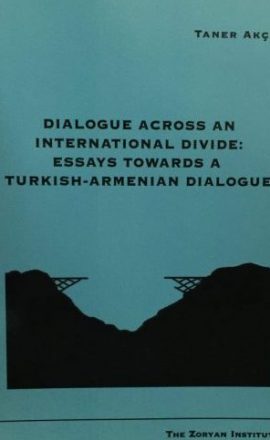
Dialogue Across an International Divide: Essays Towards a Turkish-Armenian Dialogue
Author: Taner Akçam
Year: 2001

Dialogue Across an International Divide: Essays Towards a Turkish-Armenian Dialogue
Author: Taner Akçam
Year: 2001
For nearly 30 years, Taner Akçam has been one of the foremost proponents and a key intellectual of dialogue between Armenians and Turks. A Dialogue Across An International Divide: Essays Towards A Turkish-Armenian Dialogue offers a rich and accessible introduction to the five fundamental taboos on which the Turkish Republic was founded. Thoughtfully meticulous, Akçam unfolds an expansive history that touches on the lack of historical consciousness in Turkey, and more, its contribution to the persistent and pervasive denial of the first genocide of the twentieth century, the Armenian Genocide.
Inspired by the questions that transpired following the International Conference on the Problems of Genocide organized by the Zoryan Institute in 1995 in Yerevan, Akçam sought to examine the obstacles, the problems, and the possibilities for overcoming denial narratives. In the process, it attempts to make a contribution to the process of dialogue between Turks and Armenians.

Key Elements in the Turkish Denial of the Armenian Genocide: A Case Study of Distortion and Falsification
Author: Vahakn N. Dadrian
Year: 1999

Key Elements in the Turkish Denial of the Armenian Genocide: A Case Study of Distortion and Falsification
Author: Vahakn N. Dadrian
Year: 1999
The initiative for this book came from an invitation by a congressional group to respond to the denial efforts of the Turkish Ambassador in Washington in 1999. A detailed, major rebuttal was prepared by the staff and board members at the Zoryan Institute within a short time and provided to every member of Congress. In 2005, an expanded version of this report was published and translated into Armenian by the Director of the Zoryan Institute, Vahakn N. Dadrian.
The extended book is an impressive display of meticulous scholarship. Using incisive and cogent argumentation, as well as primary documentary evidence, especially from Turkish and German sources, Dadrian deals with and sets the record straight on such issues as: The Allegation of Inter-Communal Clashes; The Fallacy of the Argument of Armenian Rebellion; the Nuremberg Trials and the Armenian Genocide; The Crusade Against American Ambassador Morgenthau, and many other topics. This is a compact work intended to confront and expose the fallacy of all the principal features of the Turkish denial syndrome. As such, it is bound to remain a potent weapon in the fight for truth and justice for a very long time.

Forces and Factors
Author: Zoryan Institute
Year: 2020

Forces and Factors
Author: Zoryan Institute
Year: 2020
Forces and Factors is the Zoryan Institute art book. Featuring multimedia artists, this book presents both the academic work of the Institute and artistic representations of the forces and factors that shape our lives relating to the topics of genocide, human rights, diaspora, and homeland relations. Access the Virtual Art Gallery version of this book.
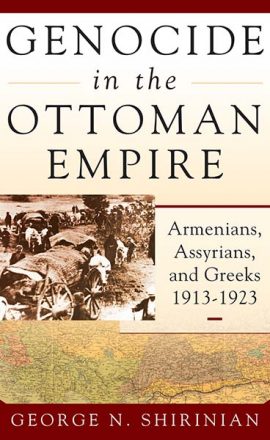
Genocide in the Ottoman Empire: Armenians, Assyrians, and Greeks, 1913-1923
Author: George N. Shirinian
Year: 2017

Genocide in the Ottoman Empire: Armenians, Assyrians, and Greeks, 1913-1923
Author: George N. Shirinian
Year: 2017
The final years of the Ottoman Empire were catastrophic ones for its non-Turkish, non-Muslim minorities. From 1913 to 1923, its rulers deported, killed, or otherwise persecuted staggering numbers of citizens in an attempt to preserve “Turkey for the Turks,” setting a modern precedent for how a regime can commit genocide in pursuit of political ends while largely escaping accountability. While this brutal history is most widely known in the case of the Armenian genocide, few appreciate the extent to which the Empire’s Assyrian and Greek subjects suffered and died under similar policies. This comprehensive volume is the first to broadly examine the genocides of the Armenians, Assyrians, and Greeks in comparative fashion, analyzing the similarities and differences among them and giving crucial context to present-day calls for recognition.
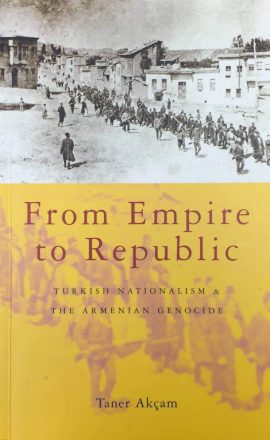
From Empire to Republic: Turkish Nationalism and the Armenian Genocide
Author: Taner Akçam
Year: 2004

From Empire to Republic: Turkish Nationalism and the Armenian Genocide
Author: Taner Akçam
Year: 2004
The Zoryan Institute and Zed books of London, England are pleased to announce the publication of a groundbreaking new book by Turkish scholar Taner Akçam, entitled From Empire to Republic: Turkish Nationalism and the Armenian Genocide.
This extraordinary book examines the relationship between Turkey’s transition from Ottoman Empire to Turkish Republic, the Armenian Genocide, and the process of democratization in Turkey today. From Empire to Republic is a significant step towards addressing the taboo in Turkey regarding the Armenian Genocide and creating a meaningful, historical dialogue.
The first three chapters provide the reader with a framework for understanding Turkish nationalism, its origins, and its ongoing relationship to the Armenian Genocide. In chapters four and five, Akçam follows the changes in Ottoman Turkey’s political climate that led to the decision for genocide and the implementation of Genocide itself. He then tracks the impact of this history into the Republic.
In this book, Akçam convincingly makes the case that debate about the Armenian Genocide is not only a measure of Turkey’s democratization, but a necessary ingredient of the process itself.
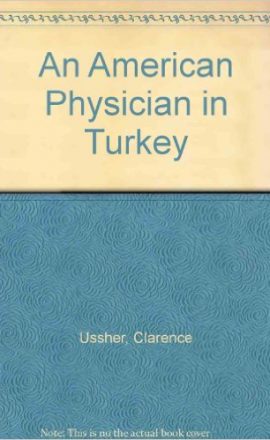
An American Physician in Turkey: A Narrative of Adventures in Peace and War
Author: Clarence D. Ussher
Year: 1990

An American Physician in Turkey: A Narrative of Adventures in Peace and War
Author: Clarence D. Ussher
Year: 1990
Originally published in 1917, this is the memoir of Dr. Clarence D. Ussher, who served as a doctor and missionary in Marsovan, Harput and Van from 1898 to 1915. It contains eyewitness information about the massacres of Van in 1915. This book is utilized in Atom Egoyan’s film Ararat as the basis for the story of “the film within a film.”
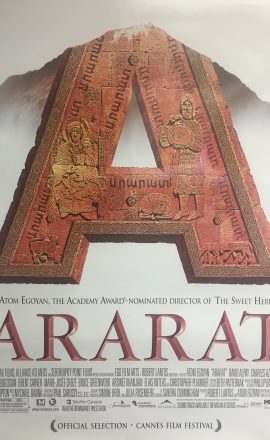
Ararat: The Shooting Script
Author: Atom Egoyan
Year: 2002

Ararat: The Shooting Script
Author: Atom Egoyan
Year: 2002
Egoyan’s Ararat is a contemporary story of two estranged families and their search for reconciliation and truth. A film-within-a-film, it is also a historical re-enactment being made by a famous Armenian director, Edward Saroyan, whose production is based on Clarence D. Ussher’s book, An American Physician in Turkey, which depicts the siege of Van and the Armenian Genocide of 1915. In the style of The Sweet Hereafter and his other works, Egoyan shifts seamlessly through time, exploring the quest for personal, sexual and cultural identity through the intimate moments shared by lovers, families, enemies and strangers.
In addition to the script, there is an introduction by Egoyan, and an essay by Timothy Taylor, who spent a year observing and talking with Egoyan during production and post. He takes readers behind the scenes to show how Egoyan collaborated with producer Robert Lantos, director of photography Paul Sarossy, composer Mychael Danna, and his actors, including his wife, Arsinée Khanjian.

Der Volkermord an den Armeniern 1915/16: Dokumente aus dem Politishcen Archiv des deutschen Auswrtigen Amts
Author: Wolfgang Gust
Year: 2005

Der Volkermord an den Armeniern 1915/16: Dokumente aus dem Politishcen Archiv des deutschen Auswrtigen Amts
Author: Wolfgang Gust
Year: 2005
One of the Institute’s most groundbreaking achievements to date is supporting the editing, translation, and publication, in addition to financial sponsorship, of the book, “The Armenian Genocide: Evidence from the German Foreign Office Archives, 1915-1916.
Wolfgang Gust, through his tireless efforts, painstakingly collected, restored, and published documents from the German Foreign Office Archive with the assistance of his wife, Ingrid Gust.
This extensive selection contains some 218 telegrams, letters and reports from German consular officials in the Ottoman Empire to the Foreign Office in Berlin describing the unfolding genocide of the Armenians.
The material is unimpeachable by those who would deny the Armenian Genocide, as it is from Turkey’s own wartime ally. It provides researchers with a deeper understanding of the actions and the motives of the perpetrators of the Armenian Genocide.
The German edition of the book played a major role in the German Parliament’s recognition of the Armenian Genocide on June 2, 2016. In fact, the Co-Chair of the Green Alliance Party, Cem Ozdemir, stated in a recent visit to the Institute in 2017:
“Wolfgang Gust’s work and that of the Zoryan Institute was very crucial, because it was the first time that we saw the documents of the German Foreign Ministry, and these documents are probably the best saved archive in the world on the Armenian Genocide.”
The Institute’s staff assisted with the publishing of the book in German (2005) and Turkish (2012) and the translation, editing and publication of the book in English (2014).
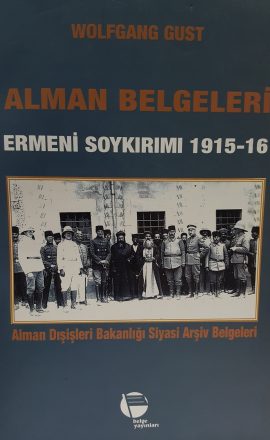
Alman Belgeleri Ermeni Soykırimı 1915-16: Alman Dışişleri Bakanlığı Siaysi Arşiv Belgeleri
Author: Wolfgang Gust, Belge Yayınları
Year: 2012

Alman Belgeleri Ermeni Soykırimı 1915-16: Alman Dışişleri Bakanlığı Siaysi Arşiv Belgeleri
Author: Wolfgang Gust, Belge Yayınları
Year: 2012
One of the Institute’s most groundbreaking achievements to date is supporting the editing, translation, and publication, in addition to financial sponsorship, of the book, “The Armenian Genocide: Evidence from the German Foreign Office Archives, 1915-1916.
Wolfgang Gust, through his tireless efforts, painstakingly collected, restored, and published documents from the German Foreign Office Archive with the assistance of his wife, Ingrid Gust.
This extensive selection contains some 218 telegrams, letters and reports from German consular officials in the Ottoman Empire to the Foreign Office in Berlin describing the unfolding genocide of the Armenians.
The material is unimpeachable by those who would deny the Armenian Genocide, as it is from Turkey’s own wartime ally. It provides researchers with a deeper understanding of the actions and the motives of the perpetrators of the Armenian Genocide.
The German edition of the book played a major role in the German Parliament’s recognition of the Armenian Genocide on June 2, 2016. In fact, the Co-Chair of the Green Alliance Party, Cem Ozdemir, stated in a recent visit to the Institute in 2017:
“Wolfgang Gust’s work and that of the Zoryan Institute was very crucial, because it was the first time that we saw the documents of the German Foreign Ministry, and these documents are probably the best saved archive in the world on the Armenian Genocide.”
The Institute’s staff assisted with the publishing of the book in German (2005) and Turkish (2012) and the translation, editing and publication of the book in English (2014).
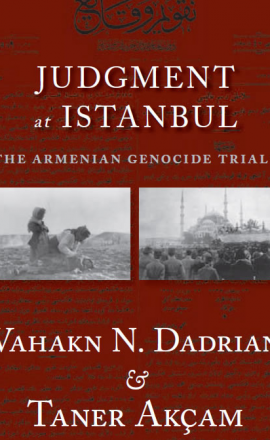
Judgment at Istanbul: The Armenian Genocide Trials
Author: Vahakn N. Dadrian and Taner Akçam
Year: 2011

Judgment at Istanbul: The Armenian Genocide Trials
Author: Vahakn N. Dadrian and Taner Akçam
Year: 2011
This book provides vital background information and is a prime source of legal evidence and authentic Turkish eyewitness testimony of the intent and the crime of genocide against the Armenians. After a long and painstaking effort, the authors, one an Armenian, the other a Turk, generally recognized as the foremost experts on the Armenian Genocide, have prepared a new, authoritative translation and detailed analysis of the Takvim-i Vekâyi, the official Ottoman Government record of the Turkish Military Tribunals concerning the crimes committed against the Armenians during World War I. The authors have compiled the documentation of the trial proceedings for the first time in English and situated them within their historical and legal context. These documents show that Wartime Cabinet ministers, Young Turk party leaders, and a number of others inculpated in these crimes were court-martialed by the Turkish Military Tribunals in the years immediately following World War I. Most were found guilty and received sentences ranging from prison with hard labor to death. In remarkable contrast to Nuremberg, the Turkish Military Tribunals were conducted solely on the basis of existing Ottoman domestic penal codes. This substitution of a national for an international criminal court stands in history as a unique initiative of national self-condemnation. This compilation is significantly enhanced by an extensive analysis of the historical background, political nature and legal implications of the criminal prosecution of the twentieth century’s first state-sponsored crime of genocide.
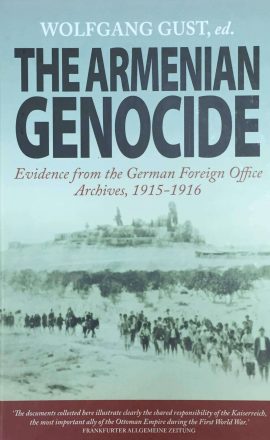
The Armenian Genocide: Evidence from the German Foreign Office Archives, 1915-1916
Author: Wolfgang Gust
Year: 2014

The Armenian Genocide: Evidence from the German Foreign Office Archives, 1915-1916
Author: Wolfgang Gust
Year: 2014
One of the Institute’s most groundbreaking achievements to date is supporting the editing, translation, and publication, in addition to financial sponsorship, of the book, “The Armenian Genocide: Evidence from the German Foreign Office Archives, 1915-1916.”
Wolfgang Gust, through his tireless efforts, painstakingly collected, restored, and published documents from the German Foreign Office Archive with the assistance of his wife, Ingrid Gust.
This extensive selection contains some 218 telegrams, letters and reports from German consular officials in the Ottoman Empire to the Foreign Office in Berlin describing the unfolding genocide of the Armenians.
The material is unimpeachable by those who would deny the Armenian Genocide, as it is from Turkey’s own wartime ally. It provides researchers with a deeper understanding of the actions and the motives of the perpetrators of the Armenian Genocide.
The German edition of the book played a major role in the German Parliament’s recognition of the Armenian Genocide on June 2, 2016. In fact, the Co-Chair of the Green Alliance Party, Cem Ozdemir, stated in a recent visit to the Institute in 2017:
“Wolfgang Gust’s work and that of the Zoryan Institute was very crucial, because it was the first time that we saw the documents of the German Foreign Ministry, and these documents are probably the best saved archive in the world on the Armenian Genocide.”
The Institute’s staff assisted with the publishing of the book in German (2005) and Turkish (2012) and the translation, editing and publication of the book in English (2014).
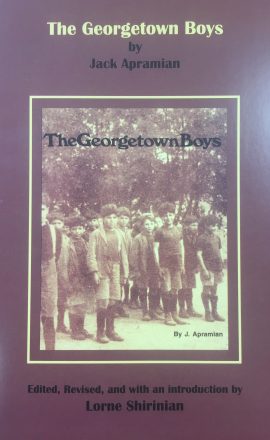
Georgetown Boys
Author: Jack Apramian
Edited: Lorne Shirinian
Year: 2009

Georgetown Boys
Author: Jack Apramian
Edited: Lorne Shirinian
Year: 2009
This is the story of the Georgetown Boys told by one of the boys, himself. Having lost everything, the most precious thing remaining to them was the memory of their families and their heritage. Based on original documentary research, interviews, and first-hand experience, Jack Apramian gives detailed insight into the daily lives of the boys, the challenges they faced adapting to their new country, and how they fared. Their story is told with a sense of humour, humanity, and history. An account of the dark and light moments that made up these rescued boys’ reality and the resilience of children, this book is essential to our understanding of multiculturalism’s best intentions.
Prof. Lorne Shirinian has edited and revised the late Jack Apramian’s classic book and provided a new introduction, setting the story in its historical context, both Armenian and Canadian. He has included previously unpublished documents and photos, enhanced the photographs, and added appendices of a list of the Georgetown Girls and information sources on the Georgetown Boys.

The Sumgait Tragedy
Author: Edited by Samuel Shahmuratian
Year: 1990

The Sumgait Tragedy
Author: Edited by Samuel Shahmuratian
Year: 1990
The pogroms against Armenians in February 1988 in Sumgait blocked a political solution to the peaceful demands of the Armenians for self-determination. They brought death to a community and ran people out of their homes. They showed the helplessness or unwillingness of a powerful government to protect its people.
In The Sumgait Tragedy, forty-five eyewitnesses and victims of the attacks tell what they saw and suffered. The accounts, based on tape-recorded interviews, also make clear what the Armenians did not see: a serious, effective effort by authorities to fulfill the first duty of any government – to protect its citizens. Why were warnings that violence was ready to flare up not heeded? Why did measures taken to halt the attacks come too late? How accurate is the Soviet description of the events as the violence of a small group of hooligans?
Such questions go beyond the fate of the victims of the Sumgait pogroms. They raise doubts about the motives of the current Soviet government and about its ability to meet the rightful demands of its peoples. As Yelena Bonner writes, “…our regime fears unsanctioned popular movements more than anything else… the government’s lack of understanding and its inability to cope provided time for the dark forces to plan what happened in Sumgait.”
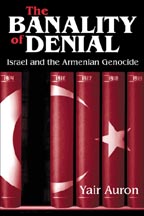
The Banality of Denial: Israel and the Armenian Genocide
Author: Yair Auron
Year: 2003

The Banality of Denial: Israel and the Armenian Genocide
Author: Yair Auron
Year: 2003
This book examines the current attitudes of the State of Israel and its leading institutions toward the Armenian Genocide. While numerous Jewish scholars in and outside Israel affirm the Armenian Genocide without reservation, the book explores both passive, indifferent attitudes of Israeli institutions and government, as well as active measures to undermine attempts at safeguarding the memory of the Armenian Genocide.

The Making of Nagorno-Karabagh From Secession to Republic
Author: Edited by Levon Chorbajian
Year: 2001

The Making of Nagorno-Karabagh From Secession to Republic
Author: Edited by Levon Chorbajian
Year: 2001
The first major territorial struggle in the late Soviet period involved Nagorno-Karabagh, an Armenian inhabited territory that had been assigned to the Azerbaijan Soviet Socialist Republic in the early 1920s. Armenian protests calling for reunification with Armenia in 1988 led to Azerbaijani pogroms against Armenians and later to armed conflict that claimed over twenty thousand lives. The struggle remains unresolved. A distinguished group of historians and social scientists analyze the Karabagh struggle in this unique volume that covers one of the world’s strategic, oil-rich regions.
A striking feature of the Karabagh conflict is the failure of the many OSCE, UN, and regional power mediation efforts to find a solution to the crisis. One of the major contributions of this volume is to provide a cogent analysis of these failures, which have to do with the inability to satisfy the legitimate security needs of the parties to the conflict, and, especially, Armenia, Azerbaijan, and Nagorno-Karabagh.
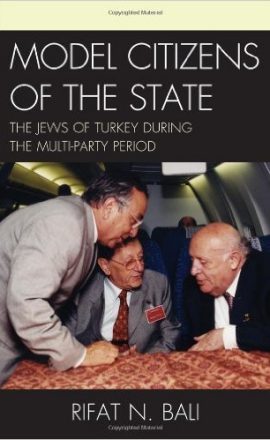
Model Citizens of the State
Author: Rifat N. Bali
Year: 2012

Model Citizens of the State
Author: Rifat N. Bali
Year: 2012
This book provides an exposé of the treatment of the Jewish community in Turkey from 1950 to the present, their fight against anti-Semitism, the struggle for their constitutional rights, and the attitude of the Turkish state and society towards these problems.
In 2013, Zoryan launched the English translation of this seminal text. Turkish journalist, Ayse Gunaysu, described the book as:
“groundbreaking…a first-hand account that unmistakably illustrates how the Turkish establishment blackmailed the leaders of the Jewish community – and through them Jewish organizations in the United States. This was to secure their support of the Turkish position against the Armenians’ campaign for genocide recognition, indicating that if the Jewish lobby failed to prevent Armenian initiatives abroad – Turkey might not be able to guarantee the security of Turkish Jews...”
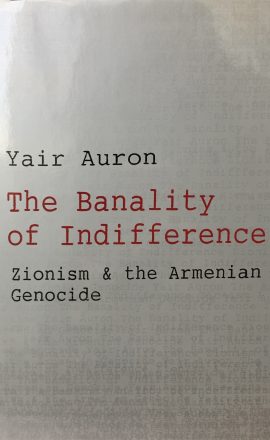
The Banality of Indifference
Author: Yair Auron
Year: 2003

The Banality of Indifference
Author: Yair Auron
Year: 2003
Israeli historian, Dr. Yair Auron, raises theoretical, philosophical, and moral questions about concepts of genocide and the uniqueness of the Jewish Holocaust. After a brief historical introduction, Auron discusses the reaction to the Genocide within the Yishuv in terms of practical assistance for and identification with the Armenians.
The Jewish position was unquestionably difficult during the period of the First World War; Palestine was under Ottoman control, and Germany, a Turkish ally, was looked to by some Zionists as a potential source of support. Consequently, the official Yishuv reaction was muted and largely self-interested: there was no condemnation in journals, internal protocols, or letters.
Auron does record instances of Jewish support, however: the Nili group, an underground intelligence organization, actively sought to aid the Armenian victims; Chaim Weizman and Nahum Sokolov publicly condemned the killings; and other Zionist writers and journalists expressed outraged identification with the Armenians and tried to arouse the conscience of the world. In attempting to analyze and interpret these disparate reactions, Auron maintains a fair-minded balance in assessing claims of altruism and self-interest, expressed in universal, not only Jewish, terms.
This book seeks both to examine the passive Israeli attitude towards the Armenian Genocide, and to explore active Israeli manures to undermine attempts at safeguarding the memory of the Armenian victims of the Turkish persecution.
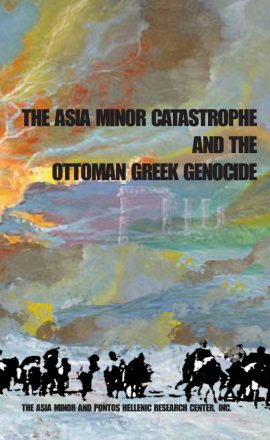
The Asia Minor Catastrophe and the Ottoman Greek Genocide: Essays on Asia Minor, Pontos, and Eastern Thrace, 1912-1923
Author: George N. Shirinian
Year: 2012

The Asia Minor Catastrophe and the Ottoman Greek Genocide: Essays on Asia Minor, Pontos, and Eastern Thrace, 1912-1923
Author: George N. Shirinian
Year: 2012
The Asia Minor Catastrophe and the Ottoman Greek Genocide: Essays on Asia Minor, Pontos, and Eastern Thrace, 1913-1923 edited by George N. Shirinian, Executive Director of the Zoryan Institute, is a compilation of innovative papers given by distinguished scholars at two academic conferences organized by the Asia Minor and Pontos Hellenic Research Center in Chicago.
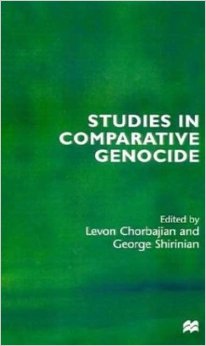
Studies in Comparative Genocide
Author: Levon Chorbajian
George N. Shirinian
Year: 1999

Studies in Comparative Genocide
Author: Levon Chorbajian
George N. Shirinian
Year: 1999
Many of the world’s leading authorities in history, sociology, political science and psychology shed new light on the major genocides of the 20th century in this book from Macmillan Press of London. The volume covers the genocides of the Armenians, Bosnians, Gypsies, Jews, Rwandans, and Ukrainians, and also topics of genocide denial and prevention. Many of the world’s leading authorities in history, sociology, political science and psychology shed new light on the major genocides of the 20th century in this book from Macmillan Press of London. The volume covers the genocides of the Armenians, Bosnians, Gypsies, Jews, Rwandans, and Ukrainians, and also topics of genocide denial and prevention.
Chorbajian is Professor of Sociology at the University of Massachusetts, Lowell and Chairman of the Board of Directors of the Zoryan Institute. “These fourteen papers originated in a conference held in Yerevan in April 1995, which the Zoryan Institute co-sponsored with the Republic of Armenia’s National Commission on the 80th Anniversary Commemoration of the Armenian Genocide. The authors have had a chance to revise and update their papers and now present them to the scholarly world.”
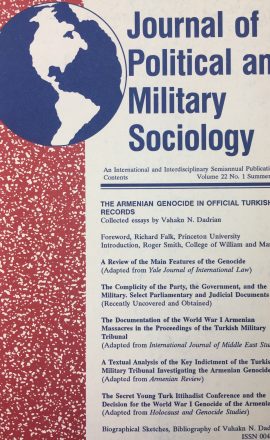
Journal of Political and Military Sociology: Volume 22 No. 1
Author: Vahakn N. Dadrian
Year: 1994

Journal of Political and Military Sociology: Volume 22 No. 1
Author: Vahakn N. Dadrian
Year: 1994
The Armenian Genocide in Official Turkish Records: Collected Essays by Vahakn N. Dadrian. A Special Issue of The Journal of Political and Military Sociology. Vol. 22, no. 1 (Summer 1994).
In the 1970s Prof. Vahakn Dadrian helped to create the field of the comparative study of genocide, bringing to his work an interdisciplinary perspective that joined sociology, history, and law, enriched further by his ability to drawn upon half a dozen languages. The archival work that he has done on three continents is the basis for the studies that appear in this special issue, studies that focus on documentation of the Armenian Genocide in Turkish sources and in those of Turkey’s World War I allies, Germany and Austria. The latter confirm that the Genocide took place, that it was centrally planned, and that a prominent motive for Turkey’s entry into the war was the cover war could provide for a final solution to the Armenian Question. Most of the documents are Turkish, and these too bear out the premeditated and intentional destruction of the Armenians. But the Turkish materials also allow Prof. Dadrian to describe in great detail, and with new insight, the organization and implementation of the Genocide. Almost all of the materials were uncovered by Prof. Dadrian and first made public by him. Most of the documents included in the article, “The Complicity of the Party, the Government, and the Military” are published here for the first time.
The contents of this special issue are as follows:
Foreword by Richard Falk
Introduction by Roger Smith
Articles by Vahakn Dadrian:
• A Review of the Main Features of the Genocide
• The Complicity of the Party, the Government, and the Military: Select Parliamentary and Judicial Documents
• The Documentation of the World War I Armenian Massacres in the Proceedings of the Turkish Military Tribunal
• A Textual Analysis of the Key Indictment of the Turkish Military Tribunal Investigating the Armenian Genocide
• The Secret Young Turk Ittihadist Conference and the Decision for the World War I Genocide of the Armenians

The Armenian Genocide Within A Framework of Compelling Evidence
Author: Vahakn Dadrian
Year: 2002

The Armenian Genocide Within A Framework of Compelling Evidence
Author: Vahakn Dadrian
Year: 2002
The book contains the printed text of a lecture by noted genocide specialist Prof. Vahakn Dadrian given at Harvard. It incorporates an introduction by Prof. James Russell of Harvard University, a brief biography of Prof. Dadrian, and an extensive, up-to-date bibliography of the noted scholar’s writings. The lecture, titled “The Armenian Genocide and the Principle of Compelling Evidence,” was delivered before a packed audience of some 500 people, including faculty and students of Harvard University at a commemoration of the 86th anniversary of the Armenian Genocide.
In the lecture, Dadrian begins by explaining the key points of the denial by the perpetrator camp and the need of an appropriate methodology suited to counter and overwhelm this culture of persistent denial. In Dadrian’s definition, this is called the methodology of “compelling evidence,” that revolves around the principles of reliability, explicitness, incontestability, verifiability. Dadrian then proceeds to reconstruct the Armenian Genocide in terms of its four major components: premeditation, genocidal intention, the organization of the genocide, and the implementation of the genocide.
The Zoryan Institute is also offering as part of this package Dadrian’s most recent article, which appeared earlier this year in The International Journal of Middle East Studies. Titled “The Armenian Question and the Wartime Fate of the Armenians as Documented by the Officials of the Ottoman Empire’s World War I Allies: Germany and Austro-Hungary,” this major article is the product of some two dozen trips to such archival centers as Bonn, Potsdam, Freiburg im Breisgau in Germany, and Vienna, Austria over the last twenty years. Supported and corroborated by 115 endnotes, it is the result of extensive research and is one of the most definitive analyses exposing the premeditated genocide of the Armenians. It should further be noted that this journal, published by Cambridge University Press, is the official organ of the Middle East Studies Association, to which dozens of Turkish historians, and experts on the Middle East, Ottoman Empire, as well as modern Turkey belong.
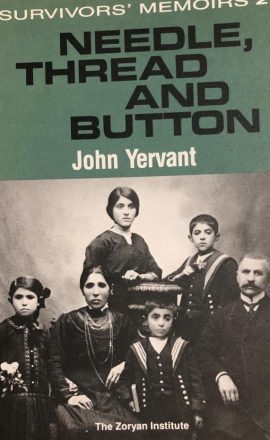
Needle, Thread and Button
Author: John Yervant Kouyoumjian
Year: 1988

Needle, Thread and Button
Author: John Yervant Kouyoumjian
Year: 1988
Born in Garin (Erzerum), the heartland of historic Armenia, young Yervant Kouyoumjian lived through the horrors of the deportations and massacres of Armenians under Ottoman rules during the First World War. John Yervant witnessed the disintegration of his family and people as the deportations led him from Erzerum to Erzingan, Egin, Arapgir, and Malatia on their way to the slaughter houses in Northern Syria. Young Yervant was able to escape death with his mother and reach Aleppo. From there he went to Istanbul, then to the newly established Republic of Armenia, to Greece, Sicily, France and, finally, to America.
Yervant Kouyoumjian, who later used his father’s name and is also known as John Yervant, narrates here the story of his survival, apprenticeship in various trades, and successes as a performer and restauranteur.
Currently retired and living in Washington, D.C., John Yervant Kouyoumjian recorded his memoirs in the 1960s. The current volume is based on the transcriptions of those tapes and additional information obtained during interviews in 1985 and 1986 with the author. The style remains conversational and unpretentious; it communicates the experience of the survivor with immediacy and a sense of humor.
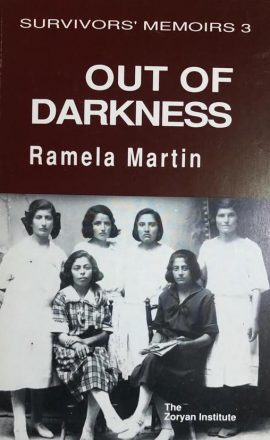
Out Of Darkness
Author: Ramela Martin
Year: 1989

Out Of Darkness
Author: Ramela Martin
Year: 1989
Out of Darkness is the story of Ramela Der Pilibosian Martin who was born in Malatia, Western or Ottoman Armenia, just before the Genocide of 1915-1917. Her father had died before she was born. After the disappearance of her brother and the deportation of her grandfather by the Turks, Ramela Martin and her mother were forced to join the death marches, but not before her mother arranged to leave Ramela’s older sister with a Turkish family. Escaping from the death marches, the women tried to return to their home but her mother died on the way, leaving Ramela alone. She was eventually rescued by the Near East Relief and placed in an orphanage. From the interior of Anatolia, Ramela Martin, together with other orphans, was moved to Aleppo, Beirut, Istanbul, and finally a refugee camp in Corinth, Greece.
Ramela Martin’s description of the camp is graphic and moving, as is her account of the development of her interest in the profession of nursing which she pursued at the American Women’s Hospital’s Training School in Kokinia, Greece. Having established contact with relatives, Ramela Martin left Greece to Havana where she secured a visa to immigrate to the United States.
Ramela Martin tells her story of dislocation, immigration, struggle, and survival with passion and courage. In the end, there emerges the portrait of a woman wounded by history but capable of endurance and wholeness.
Ramela Martin trained as a nurse at the American Women’s Hospital in Kokinia, Greece. After immigrating to the United States, she took the Connecticut State Board examination for nurses and received her R.N. She continued practicing and teaching her profession for twenty-seven years. In 1968, she traveled to Soviet Armenia where she was reunited with the sister whom she had lost during the Genocide. She retired in 1975, and in 1979 she and her husband, Jim Martin, moved to Florida where she now resides.
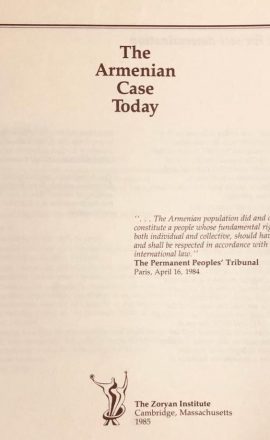
The Armenian Case Today
Author: The Zoryan Institute
Year: 1985

The Armenian Case Today
Author: The Zoryan Institute
Year: 1985
“… the Armenian population did and do constitute a people whose fundamental rights, both individual and collective, should have been and shall be respected in accordance with international law.”
The Permanent Peoples’ Tribunal, Paris, April 16, 1984
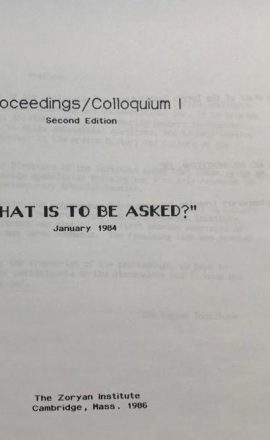
“What is to be Asked?”
Author: Colloquium Proceedings, The Zoryan Institute
Year: 1984
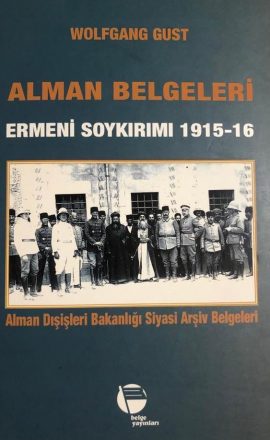
Alman Belgeleri Ermeni Soykirimi 1915-16
Author: Wolfgang Gust
Year: 2012

Alman Belgeleri Ermeni Soykirimi 1915-16
Author: Wolfgang Gust
Year: 2012
On April 24, 1915, the Unionist Government of the Ottoman Empire confiscated the entire elite of the Armenian community in the capital Istanbul. The systematic extermination of the Armenian people followed a few months later. During and after the death march, many people lost their lives in the mountainous regions or in the Syrian deserts due to thirst and hunger. At that time, more than half of the Armenian people, who had a population of about 2 million in the Ottoman Empire, died. This event went down in history as the First Genocide of the Twentieth Century. During the First World War, Turkey’s biggest ally of the German Empire missions, teachers, officers, ambassadors and their embassy, in a way that no foreign state can not follow, had registered the details of this genocide. On the other hand, some German officers actively participated in the extermination of the Armenians. The documents compiled by Wolfgang Gust from the reports collected in the Ministry of Foreign Affairs Archive provide a complete picture of the events that have taken place, as well as the responsibility of the Germans.
(Translated from Turkish)
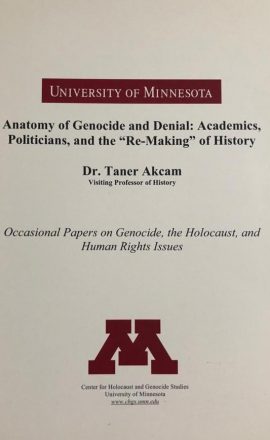
Anatomy of Genocide and Denial: Academics, Politicians, and the “Re-Making” of History
Author: Taner Akcam
Year:
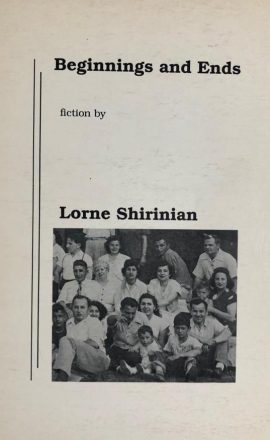
Beginnings and Ends
Author: Lorne Shirinian
Year: 1991
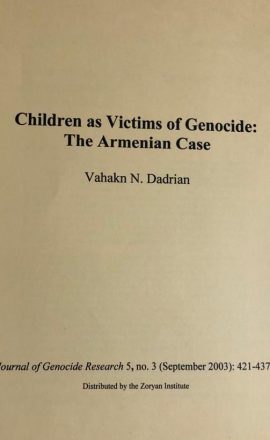
Children as Victims of Genocide: The Armenian Case
Author: Vahakn N. Dadrian
Year: 2003
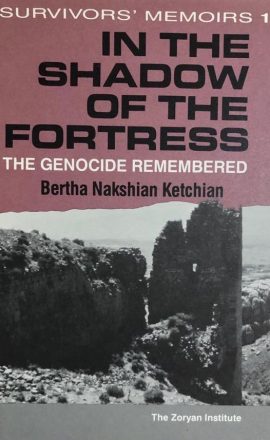
In the Shadow of the Fortress
Author: Bertha Nakshian Ketchian
Year:
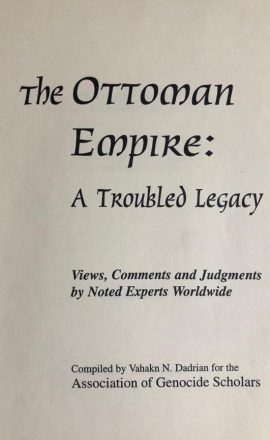
The Ottoman Empire: A Troubled Legacy
Author: Compiled by Vahakn N. Dadrian
Year:
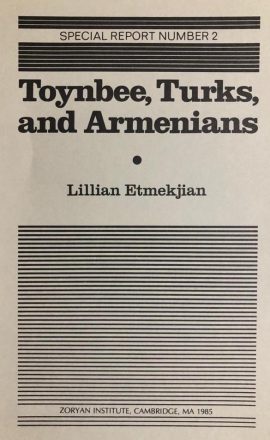
Toynbee, Turks, and Armenians
Author: Lillian Etmekjian
Year: 1985
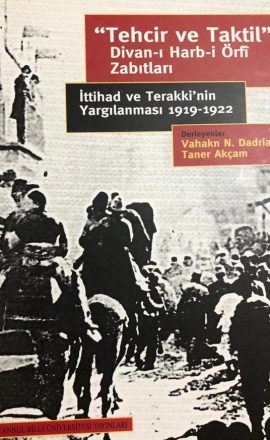
Tehcir Ve Taktil Divani Harbi Örfi Zabitlari
Author: Vahakn N. Dadrian, Taner Akcam
Year: 2009
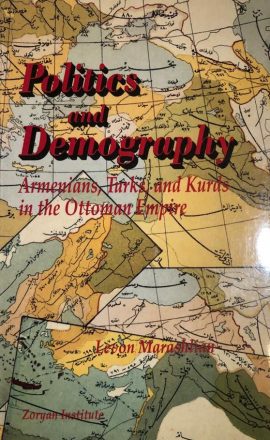
Politics and Demography
Author: Levon Marashlian
Year:

Nationalism and Socialism in the Armenian Revolutionary Movement
Author: Anaide Ter Minassian
Year: 1984

Nationalism and Socialism in the Armenian Revolutionary Movement
Author: Anaide Ter Minassian
Year: 1984
This concise volume constitutes one of the best available studies on recent Armenian history. It traces the interactions between political developments and intellectual currents which determined crucial phases in the history of the Armenian people during a period of revolutionary upheaval. The study covers the period between 1885 and 1914 when radical political organizations undertook to liberate the Armenian people from the despotism and oppression of the Ottoman and Russian empires.
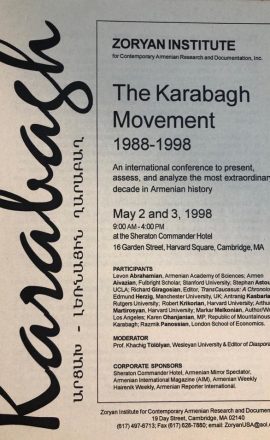
The Karabagh Movement
Author: The Zoryan Institute
Year: 1998
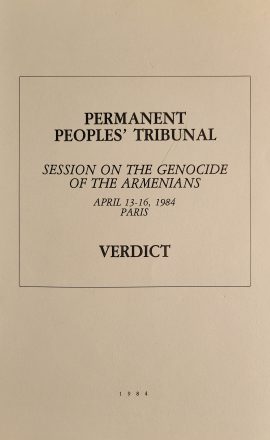
Permanent Peoples’ Tribunal: Verdict
Author: The Zoryan Institute
Year: 1984
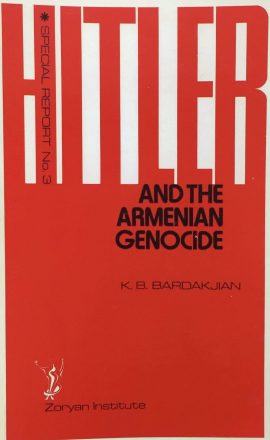
Hitler and the Armenian Genocide
Author: Kevork Bardakjian
Year: 1985

Hitler and the Armenian Genocide
Author: Kevork Bardakjian
Year: 1985
In August 1939, Hitler justified his plan to destroy Poland and create a new order by asking, “Who remembers now the extermination of the Armenians?” Hitler’s rhetorical question acquired an ominous significance with the extermination of Jews and Gypsies during the Second World War. Many scholars have argued that the absence of justice in the case of the Young Turk government, guilty of crimes against the Armenian people during the First World War, led Hitler to believe he would not be held responsible for his own crime against humanity. This link between the two major genocides of the century has led scholars to focus more on the historical and political significance of the Armenian or “forgotten” genocide.
In keeping with the objectives of the International Institute for Genocide and Human Rights Studies, this journal is dedicated to raising knowledge and awareness among scholars, policymakers, and civil society actors by providing a forum for the critical analysis of genocide, human rights, crimes against humanity, and related mass atrocities. Genocide and other forms of mass violence are constantly evolving, and we encourage scholarly submissions that address their continually changing nature. This includes interdisciplinary and comparative work on the history, causes, impact, and aftermath of genocide and related crimes, as well as those which contextualize genocide in relation to conflict, exploitation, colonialism, racism, bigotry, sexism, oppression, and globalization. We also welcome submissions that explore the challenges and prospects for the long-term prevention of genocide, as well as those that focus on global and regional threats to human security, especially as they relate to genocide. Consequently, this peer-reviewed journal publishes articles from various disciplines including, but not limited to, history, political science, sociology, psychology, international law, criminal justice, critical race studies, religion, philosophy, literature, anthropology, forensic sciences, art history, and women’s, gender, and sexuality studies.
Editors:
Prof. Henry Theriault, Worcester State University
Prof. Alex Alvarez, Northern Arizona University
Prof. Jennifer Rich, Rowan University
Prof. Adam Muller, University of Manitoba
Popular titles include:
Manuscript Submission Process (updated June 24th, 2021)
All submissions, reviews, and editorial work are done through the UTP online peer review management system. Submissions will only be accepted electronically as a Microsoft Word document. Please do not submit PDFs or locked documents.
If you are a new contributor to the journal or have contributed to the journal by submitting your article directly to the editor in the past, please visit https://mc04.manuscriptcentral.com/utp_gsi and select “Create an Account” to create a new account. You will be asked to fill in a brief contributor form. Be sure to click the “Finish” button to save your data. You will then be able to log in, using the username and password you created, and view the Author Dashboard, which is the starting point for all functions available to you as a contributor.
If you have previously used the peer review management system to contribute to the journal, please visit https://mc04.manuscriptcentral.com/utp_gsi and follow the prompts to log in. If you do not know your password, please select Reset Password to have the information sent to you.
After you submit your article, it will be evaluated. Based on this evaluation, you will receive one of the following responses: accept, accept with revisions, revise and resubmit, and reject.
Upon initial submission, all supporting files including figures and illustrations, tables, and images must be submitted in addition to the main file. Figures and illustrations should be submitted as separate image files (more below), not embedded in the main file. If you wish you can include a note in the file indicating where the supporting documents should appear (i.e., insert Figure 1 here). Should the article be accepted for publication, you will be required to resubmit supporting images in high resolution (if they were not provided in high resolution at initial submission).
Publishing in Academic Journals: A Writing Workshop
In early 2021, the Zoryan Institute held a webinar titled Publishing in Academic Journals: A Writing Workshop. The webinar was led by the esteemed editors of Genocide Studies International (GSI), Prof. Alex Alvarez of Northern Arizona University and Prof. Henry Theriault of Worcester State University. Are you looking for expert advice on publishing in academic journals?
Watch the video below.
Diaspora was founded in 1991, capturing the zeitgeist of a world where borders are transgressed and elastic, boundaries are fractured and permeable, identities increasingly fluid and adaptable. The forces of globalization reinvigorated old diasporas, and stimulated and supported the creation of new ones. Diasporas evolved from being the paradigmatic ‘Others of the Nation State’ to ‘exemplary communities of the transnational moment’ (Khachig Tölölyan, The Nation-State and its Others: in Lieu of a Preface, Diaspora 1(1991) 3-7).
The establishment of Diaspora was a seminal moment in marking what has become the field of Diaspora Studies, setting out and nurturing an expanding project that recognizes its roots in historic Jewish, Armenian, and Greek diasporas, to include and embrace transnational formations and phenomena challenging the established models and concepts for the study of nation-states, societies and cultures. This substantive transformation of the discourse of diaspora studies has entailed theoretical reflection, and a vigorous and continual rethinking of older definitions on behalf of more capacious conceptualizations of new forms of dispersion, diaspora and transnationalism. Discourses ranging from Postcolonial Studies and World Literature, and themes from environmental migrants to global networks, contribute to this work that rethinks mobility and mobilization and thus reorients traditional accounts of home, homeland, host state and diaspora. Diaspora welcomes the contributions of scholars from across the social sciences and humanities who share these intellectual concerns.
Editors:
Prof. Talar Chahinian, University of California Irvine
Prof. Sossie Kasbarian, University of Stirling
Popular titles include: